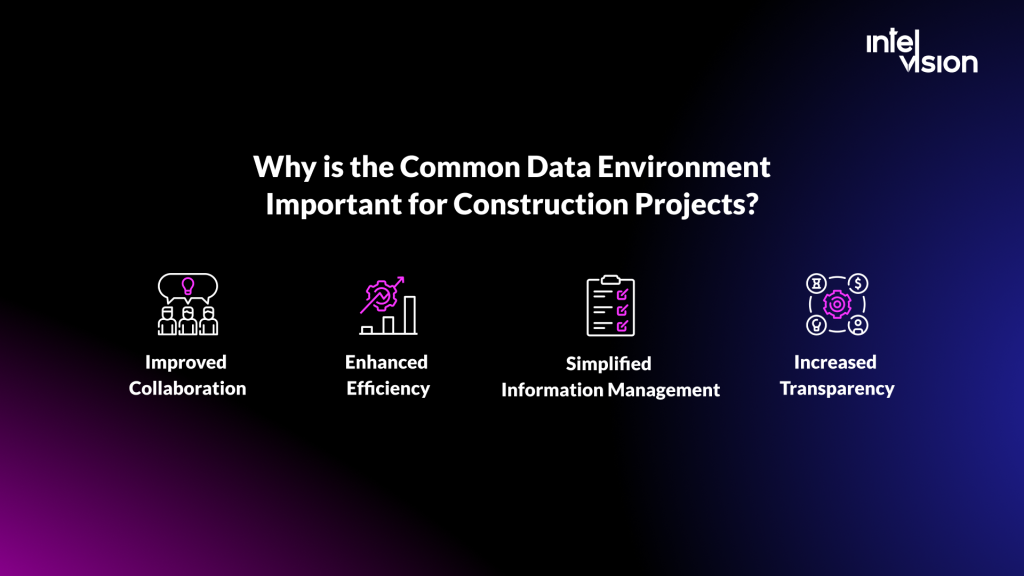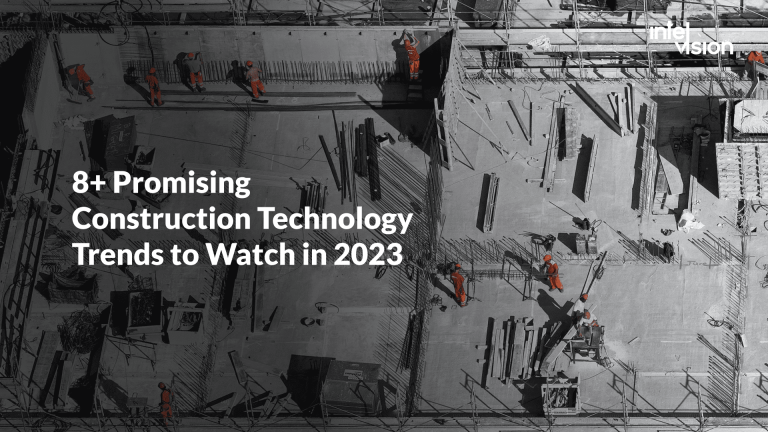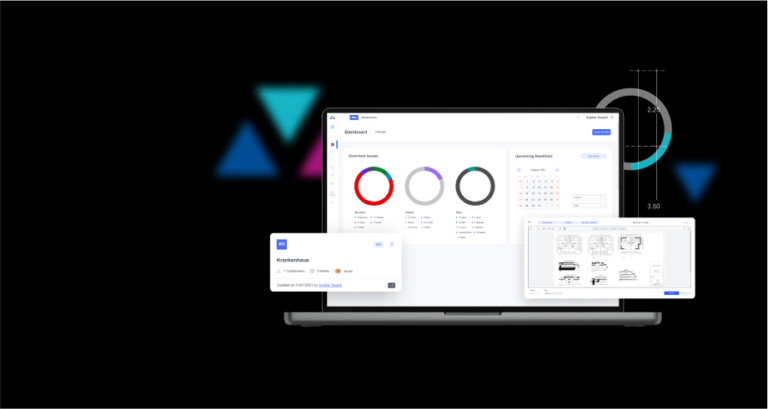
What Is a Common Data Environment and How Is It Used In the Construction Industry?
Construction projects create a massive amount of data. This data needs to be properly organized, distributed, and analyzed to run a project efficiently. That is a tall order for a team made up of different companies with different ways of managing things.
Each stakeholder often uses their set of software and tools for working with their project information. In its turn, it creates fragmented workflows that produce unreliable data. But wait for a second. Imagine a tool that stores and manages reliable construction project data for the entire project team to access. As architecture and construction teams seek ways to manage projects more efficiently and improve their bottom line, a common data environment (CDE) might be the answer. What is it, how is it related to the BIM model, and why should you care? Let’s explore it in the blog below.
What Is a Common Data Environment?
What is a CDE in construction? A Common Data Environment (CDE) is an essential tool used in construction to manage data and information across various project teams easily and effectively. It allows all parties involved in a construction project to access data, store, and manage it, including design and construction data, drawings, schedules, and reports.
The CDE makes it easier for all project stakeholders to stay updated and informed about the project’s progress, schedule, budget, and scope. Moreover, it ensures that everyone works with accurate and consistent project information, reducing the risk of errors.
Why is the Common Data Environment Important for Construction Projects?
With the Common Data Environment (CDE), all project stakeholders, from designers and contractors to clients and investors, are given access to the same up-to-date data, promoting teamwork, and encouraging open communication. The tool is critical for the construction sector for many reasons, including:
Improved Collaboration
The construction CDE allows all project stakeholders to share and collaborate on the same data in real time. This helps work together, based on the latest information, which results in faster decision-making, fewer misunderstandings, and better project outcomes.
Enhanced Efficiency
By centralizing construction project information and making it accessible to all parties, the Common Data Environment eliminates the need for multiple copies of documents or revisions. It reduces the risk of errors, duplication, or missing information as well as helps teams deliver the project on time, within budget, and according to specification.
Simplified Information Management
With the CDE, information management becomes more systematic and less chaotic. In a Common Data Environment, information is stored in a structured manner, making it easier to organize, search, and retrieve data.
Increased Transparency
The CDE provides key stakeholders with full visibility of the project, including real-time updates, changes, and documentation. This fosters transparency and builds trust. This trust results in greater adoption, which yields more project data and insights.
How Do BIM and the CDE Fit Together?
Building Information Modeling (BIM) software development is a process that involves creating and managing a graphical model of the physical and functional characteristics of a building. The Common Data Environment (CDE) is a central information repository where all project-related data is stored, managed, and shared by project team members.
BIM and CDE are closely related as they are both needed to manage construction projects effectively. BIM models contain information that needs to be shared across the project team, and the Common Data Environments provides the platform for doing that.
The integration of Building Information Modeling and Common Data Environments can help construction teams in different ways, from reducing errors and rework to improving project outcomes. Moreover, the use of BIM and CDE is becoming increasingly popular and more necessary in the construction sector. By combining two digital technologies, project teams can improve communication, reduce errors and delays, and increase efficiency and accuracy.
Benefits of Using a Common Data Environment in Construction Projects
The main advantage of the CDE in construction is that it provides complete visibility into the entire project lifecycle. This allows all stakeholders to make informed decisions, anticipate problems and delays, and take corrective actions promptly.
The Common Data Environments also supports effective collaboration between project participants, including contractors, architects, engineers, and other professionals, by providing a single source of truth.
In summary, the CDE is a critical tool in modern construction. It enables better collaboration, construction project information integration, and project coordination across various teams. By leveraging technology to enhance data management and sharing, the CDE allows stakeholders to work together more efficiently, effectively, and with greater agility.
What Challenges the Common Data Environment Can Help You With?
We’ve highlighted the main challenges in the construction industry that CDE can help with.
Collaboration
The Common Data Environment provides a platform for all stakeholders to collaborate in real time, reducing the number of face-to-face meetings and increasing efficiency.
Document management
The construction industry relies heavily on documentation. The Common Data Environments can help with managing all project documents, including drawings, specifications, contracts, and reports, in a single platform, making it easier to access and control document versions.
Data security
The Common Data Environment can provide a secure environment for project data storage, ensuring that all stakeholders have secure access to project data as and when required.
Project monitoring and control
The CDE can provide vital project data centrally, ensuring all stakeholders can monitor and control the project effectively.
How to Implement the Common Data Environment
To benefit from Common Data Environments, there are several things you should consider:
- Define the scope and requirements of the CDE: Determine the scope of the project and the key requirements that need to be fulfilled by the Common Data Environment.
- Establish a project team and allocate resources: Assemble a team of professionals with the right skills and knowledge to develop and implement the Common Data Environments. Allocate necessary resources including hardware, software, and budget.
- Choose the right software tools: Identify the best software tools that can be used to develop and implement the CDE. The tools should cover collaboration, document management, and communication.
- Develop the Common Data Environment implementation plan: Develop a plan that outlines the tasks, timelines, and milestones involved in building and implementing the CDE.
- Set up the Common Data Environment environment: Do it by configuring the software tools and integrating them with the existing systems, such as enterprise resource planning (ERP) software.
- Populate the CDE: Populate the Common Data Environment in construction with relevant data and information from project design, materials, scheduling, and budgeting.
- Train project members/the needed stakeholders: Provide comprehensive training to all stakeholders who will be using the Common Data Environment.
- Test the Common Data Environment: Run thorough tests to ensure that the tool works as expected and that all issues have been resolved.
- Launch the CDE: Launch the software after total quality management fixes are completed and operational. Provide support to ensure that the system runs smoothly, and errors are fixed quickly.
- Monitor progress to ensure that the project stays on track and meets the expected outcomes.
Visoplan Case Study: Team Extension Services for the Construction Collaborative Platform
Finally, we’ve approached the case, and we are proud to share the results of the team extension services for the Visoplan web platform. It helps to improve collaboration and advance digitization in the construction industry.
Speaking of Visoplan, the project was struggling to find a proper tech partner with the proper experience, expertise, and level of responsibility, to embody the idea into a viable product. Other two significant challenges were a tight time frame and the in-house team’s inflexibility.
We’ve provided our client with a perfect-match team, an understanding of the project, high-level project management, and a quick pace of work. The team that worked on this project consisted of three full-stack developers and two front-end developers. They used React, C#, ASP .Net Core, Razor pages, and .Net 5.0. This technology stack complimented all the solutions.
Intelvision team experience and expertise allowed the client to:
- Be flexible in terms of including new project team members, and excluding those who are no longer required.
- Collaborate with experienced developers to launch a cutting-edge product.
- Providing the customer with top-rated construction software development and consulting services.
In A Nutshell
The future of construction is data-driven. There is no doubt that the Common Data Environment will be an indispensable facilitator of this transformation.












![$portfolio_img_mobile['title'] $portfolio_img_mobile['alt']](https://intelvision.pro/wp-content/uploads/2022/11/Visoplan.-Mobile-banner-263x350.png)









